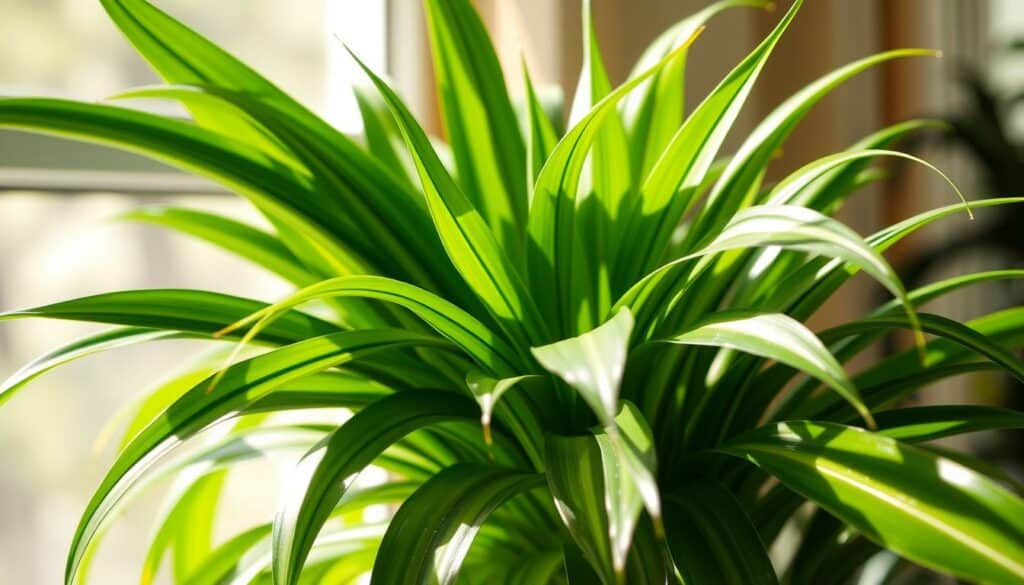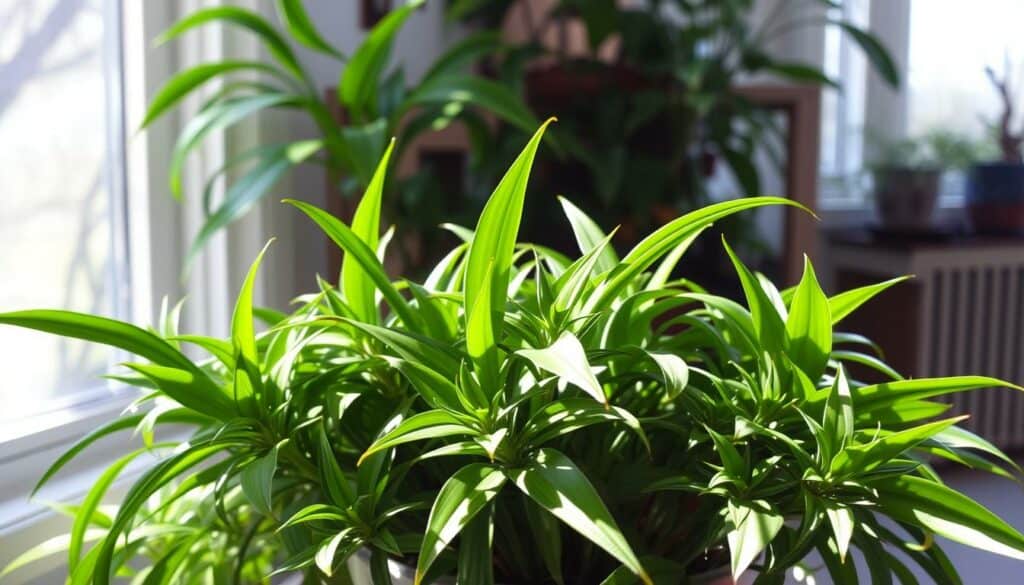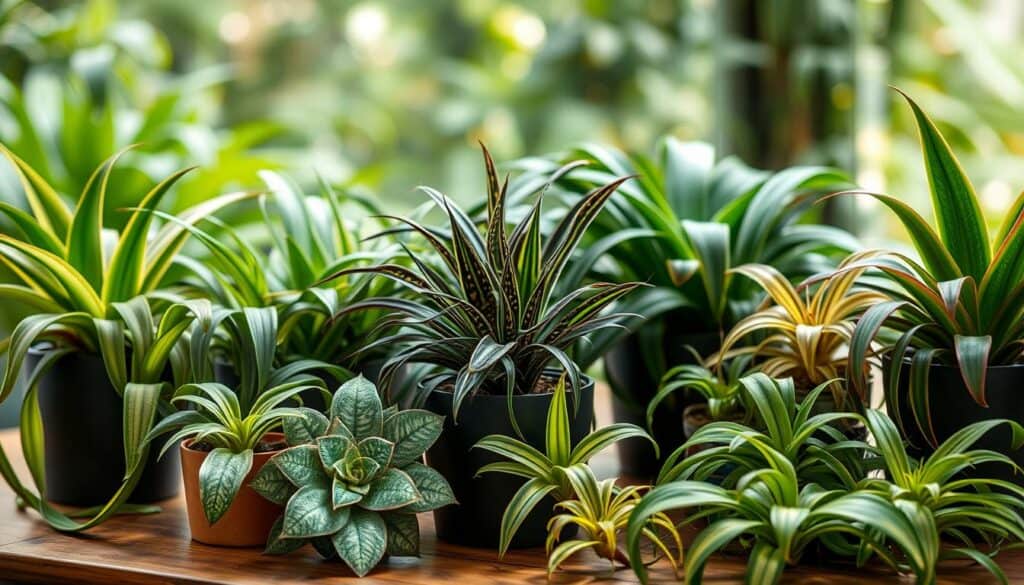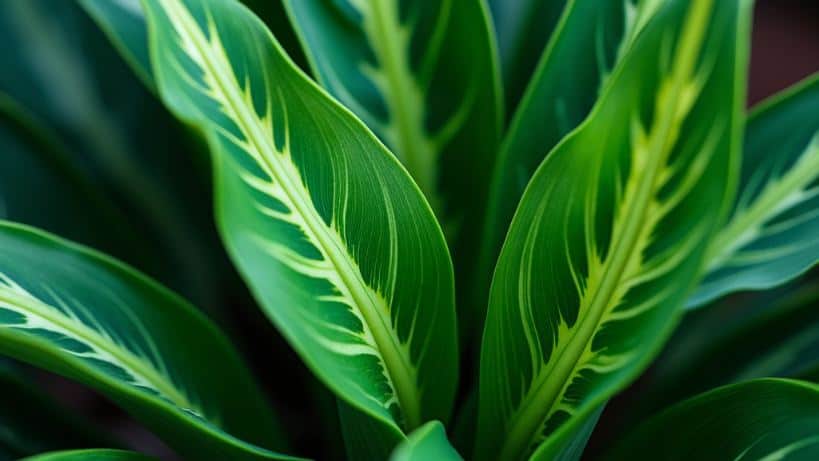A basic houseplant, the solid green spider plant (Chlorophytum comosum), can remove up to 90% of harmful toxins from the air. These plants are easy to grow and have been known for cleaning the air for years. They were even included in NASA’s Clean Air Study list. They are a quiet hero, making our air cleaner one leaf at a time.
Key Takeaways
- Solid green spider plants (Chlorophytum comosum) are great at removing toxins from indoor air.
- These plants were in NASA’s Clean Air Study for their air-cleaning skills.
- They are simple to care for and perfect for any home or office.
- With their unique look and lush green leaves, they’re great for hanging baskets and indoor gardens.
- Adding solid green spider plants to your space can make it healthier and more eco-friendly.
What are Solid Green Spider Plants?
Solid green spider plants, also known as Chlorophytum comosum, come from South Africa’s grasslands2. They are loved for their unique look and easy care. These plants grow in a rosette shape and have long stems that can be up to 2 feet long2. They also have beautiful solid green leaves and sometimes white flowers, adding beauty to any room.
Origins and Botanical Name
The name Chlorophytum comosum comes from Greek words. “Chloros” means green and “phyton” means plant, fitting these plants well2. They started in South Africa’s grasslands and now thrive in many places. This makes them great for both new and seasoned plant lovers.
Unique Growth Habit
Solid green spider plants stand out with their special way of growing. They have strap-like leaves that spread out from the middle, looking nice and easy to care for2. The stems that grow from the leaves can get quite long, often hanging down. This look has earned them the names “airplane plants” or “spider ivy.”
Caring for Solid Green Spider Plants

Caring for house plants like solid green spider plants is relatively simple, making them ideal for both novice and experienced gardeners. Here are some key care tips:
Watering Requirements
These plants like soil that drains well and should be watered when the top inch of soil is dry3. Don’t overwater, as it can cause root rot. Check the soil often and water only when needed to keep the plant healthy.
Light and Temperature Needs
Solid green spider plants do best in bright, indirect light3. They like cooler temperatures, between 60-75°F. But, they can’t take too much direct sunlight, as it can burn their leaves.
With the right care, solid green spider plants can live indoors for years3. Give them the right water, light, and temperature, and enjoy their lush green leaves and clean air.
Benefits of Solid Green Spider Plants
Air-purifying houseplants like solid green spider plants offer numerous benefits. They bring many benefits to any indoor space. These plants are great at cleaning the air, removing toxins like formaldehyde and benzene4.
NASA’s Clean Air Study found spider plants are top air cleaners4. They can purify up to 97% of the air, beating many other plants5.
These plants do more than clean the air. Being around them can make you feel less stressed, by up to 85%5. They also help people work better, by up to 15%, thanks to better air and a calmer space5.
They make any room look better, too. 92% of people say they make spaces look nicer5. They’re easy to care for and fit well in many places.
In short, solid green spider plants are amazing. They clean the air, reduce stress, and make you work better. They’re a great choice for anyone wanting a healthier, more lively home45.
Solid Green Spider Plants for Air Purification

The solid green spider plant, known as Chlorophytum comosum, is a hero for clean air. It shone bright after the NASA Clean Air Study in the late 1980s6.
NASA’s Clean Air Study
NASA looked into how plants clean the air. They found the solid green spider plant is top-notch at it. It can remove up to 90% of bad stuff like formaldehyde, benzene, and trichloroethylene in just 24 hours6.
This plant is great for homes and offices because it fights toxins. Formaldehyde is in many building materials and products. Benzene and trichloroethylene are in paints and solvents6. Adding these plants helps keep the air clean.
These plants are easy to care for. They can live in different lights and don’t mind if you forget to water them sometimes6.
So, if you want cleaner air at home or work, try a solid green spider plant. It’s easy to keep and helps make the air healthier6.
Varieties and Types of Spider Plants

While solid green spider plants are popular, there are also variegated varieties with white or yellow stripes on their leaves. Houseplants with variegated leaves like these can add an extra visual element to your indoor garden.
Both kinds of spider plants are great for homes. They clean the air and look nice too.
Variegated vs Solid Green
Variegated spider plants have leaves with stripes. They can be a beautiful sight in any room7. Solid green spider plants have a classic look. They fit well with many decor styles7.
Choosing between them depends on what you like and how you want your space to look.
Whether you pick variegated or solid green, spider plants are easy to care for7. They clean the air and have pretty foliage. This makes them popular with both new and experienced plant lovers.
“Spider plants are one of the easiest houseplants to grow and care for, making them a great option for those new to plant parenting.”
Conclusion
Whether you’re looking to improve your indoor air quality, add some greenery to your space, or start your journey into houseplants for beginners, solid green spider plants are an excellent choice. Their air-purifying abilities, combined with their low-maintenance nature and attractive appearance, make them a valuable addition to any indoor environment.
By incorporating these natural air purifiers into your home or office, you’re not just adding a decorative element – you’re taking a step towards a healthier, more vibrant living space. So why not bring the power of nature indoors with a solid green spider plant?
Source Links
- https://gamerant.com/ff16-pc-release-date-final-fantasy/
- https://www.redbluffdailynews.com/2024/09/05/alex-morgan-retires-from-professional-soccer-and-is-expecting-her-second-child/
- https://www.housebeautiful.com/lifestyle/cleaning-tips/a62051428/why-you-shouldnt-shower-right-after-cleaning-bathroom/
- https://knowinsiders.com/top-15-most-beautiful-birds-in-north-america-40159.html
- https://www.stylerave.com/best-single-player-video-games/
- https://truthout.org/articles/cornell-has-driven-up-local-cost-of-living-workers-had-no-choice-but-to-strike/
- https://theankler.com/p/wbd-sony-signal-that-buying-is-back
- http://www.nhregister.com/living/article/signs-summer-ending-connecticut-19742686.php
solid-green-spider-plants
